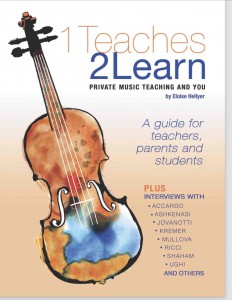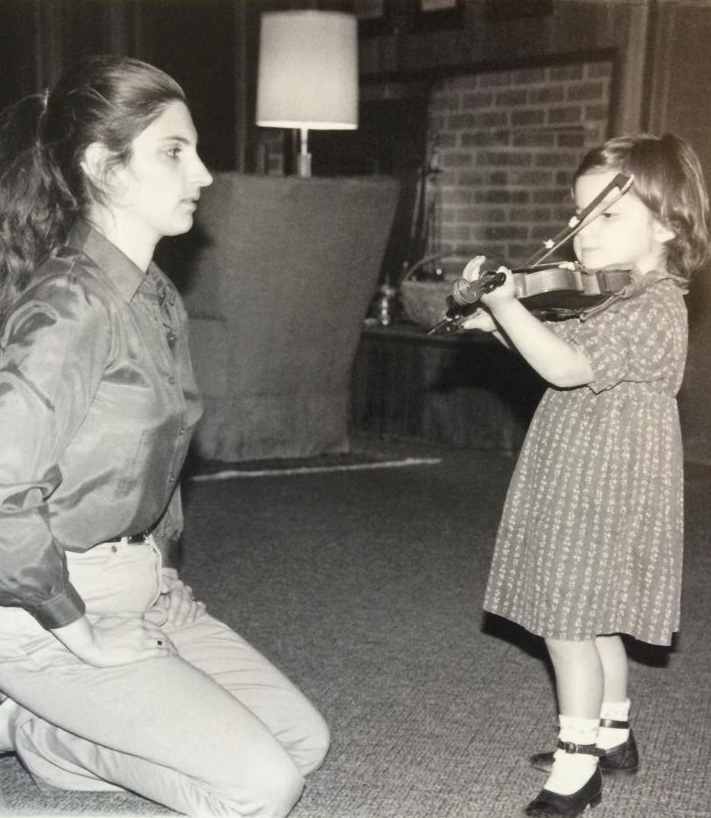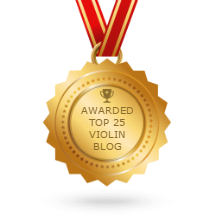The Case For Memorization, or Don’t Throw the Baby Out with the Bathwater
Recently I read a thought-provoking blog post on Violinist.com* where the author questions the use of requiring our students to play recital pieces from memory and suggests that we should teach them to learn to read music immediately to avoid problems with stage fright and fear of memory lapses.
“What is sacrificed by putting off reading music and requiring memorization for all recital performances? The child spends too much energy worrying about having a memory slip during a performance, rather than experiencing the full benefits of absorbing and expressing the music. If only a tiny percentage of soloists must memorize concerti and solo pieces, why would it be necessary to inflict such a requirement on someone performing during the their first year of lessons?”
What is sacrificed by not putting off note reading? The possibility of playing music as soon as possible in the easiest possible way. Learning to play first from memory before reading is better because:
- Students have the chance to concentrate on the technical difficulties of holding the instrument and bow.
- They learn music like a language – children speak their mother tongue for a long time before they learn to read it, thus their focus is always on listening and reproducing before reading.
- It is easier for them to learn to listen to themselves (something I hold to be one of the most difficult things to learn or to teach a student) when they don’t have to concentrate on the notes on the printed page.
- They develop muscle memory early on, a kind of memory quite different from what you develop using your eyes, and learn to trust it, thus making sure it is well in place before students start using their eyes as a crutch for their memories. I have found that once they start reading music, usually after years of memory work, some of my students don’t want to memorize anymore (they get lazy), but they know how and have no trouble doing it.
- They develop different types of memory from a photographic or visual one. And all kinds of memory are useful in life.
I can tell you what I would do if I were to have a non-reading beginner with stage fright and fear of memory slips. I would have him play something so easy that it would not be possible to mess it up, even “Twinkle, Twinkle Little Star” when he is at minuet level. The idea is to get students to feel at ease in front of the public and to trust themselves. The fact that you put off reading music does not necessarily mean that playing from memory at recitals is mandatory either. In extreme cases of stage fright you can always put some kind musical notation in front of your students who don’t read notes yet. I have found, however, that if non-readers are used to playing from memory at the lesson and for home “concerts,” they rarely make a fuss about playing from memory in recitals. Once my students understand that making mistakes of any kind is something all violinists do, that the important thing is to recover and play on and that I’ll be there where they can see me in case of a blip, there is little drama left in the situation..
The above author is right that very few violinists ever have to play solo pieces from memory. But go look at the audition requirements for most major and minor conservatories and music schools – many require audition pieces to be from memory and others merely “encourage” it. So if you want to beat out the competition, you had better have some, if not all, of your pieces memorized and be comfortable playing from memory which, I can tell you from personal and professional experience, is easier if you train the memory (the ear and the body) before the eye. You may say, “Well, most violin students are never going to go to any university violin program.” True, but can you tell who they are when they first start their studies?
“Children have a better chance of being musically well rounded if they learn music like they learn to read. School teachers don’t ask them to memorize a book, because it’s not necessary. Just as it is a natural process to teach a child to read the words that correspond to things he knows, the correlation to music is similar. Most children readily absorb simple melodies, so reading notes is the next obvious step.”
Music and schoolwork are not the same thing even though school teachers do ask students to memorize lots of things. I think we can all agree that music and language are much more similar to each other and that we have to do a lot of listening to either if we want reproduce their sounds. The problem with music is that there is an added step – the physicality of it which is really the next logical step between absorbing simple melodies and reading notes. Holding a violin and a bow is an extremely complicated endeavor. So is making a good tone. Anything that distracts the student from concentrating on these things at the beginning of his studies can be detrimental to the happiness of the student. And what makes a happy student? Making a good sound and expressing himself. Reading notes is an adjunct to this, to be added after the student has some proficiency in making music, whatever the age he or she starts. Students who make a good sound also tend to like practicing more. Those who don’t either quit or, worse, stop listening to themselves. Over the years, I have had many students who had been learning from other teachers in the the “traditional” fashion (reading notes from the beginning) and every single one of them had problems with violin and bow hold, tone production, phrasing and intonation. Why? Several reasons:
- Because they were taught to read notes from the moment they took the violin in their hands and couldn’t concentrate on the mechanics of playing.
- Peering over the scroll at the notes often means that the violin is held lower down resulting in problems also for the bow arm.
- Because their teacher insisted that they always keep rhythm no matter what, standing next to them snapping fingers in time (be true to the printed page!). The students stopped listening to themselves because they didn’t like what they were hearing. They only knew something was wrong but not what.
- Because of the above, they not only did not develop their ear, they shut it down! Their hands were getting instructions not from their ear but from their eyes, and the ear didn’t hear what the hands were doing.
Obviously this doesn’t happen to all students who start reading music from the start, but why should we risk it and make learning (and teaching) the violin even more difficult than it already is by introducing note reading before the student has mastered the basic physical and tonal aspects of the instrument?
“Fear of memorization and the accompanying stage fright could be avoided by teaching the student to read as soon as he starts playing. Some kids will be better at reading than others, and others will be better at playing by ear. The balance between these two will work themselves out, as long as they are both worked on. Try to improve the part that is weaker, so that reading and listening become evenly distributed.”
It isn’t a question of playing by ear or reading. All musicians play by ear – they have to hear mentally every note they are going to play before they play it, whether they read or play from memory, so all of them are playing “by ear.” A musician adds a step when he is reading the music: it becomes “read, hear and play” instead of just “hear and play,” but he is still playing by ear. Reading means the music passes through the mind to get to the ear. Memorization trains the ear directly. I tell my students that it’s the ear that plays the violin, that you can have the greatest right and left hand techniques in the world and still sound awful if your ear is not telling you the correct thing to do. So training the ear and the body, before the eyes, seems essential to me. I have found that reading notes while learning the rudiments of the violin distracts students from learning to listen to themselves. I ask even my adult students to look at the notes, put down the music and then play – not read and play simultaneously. It works. All my students, even the adult ones, learn to read well and play in our “orchestra” eventually.
Do we want to throw the baby out with the bath water by changing an excellent approach to music training just in case there may possibly be a problem with fear of a memory lapse? That would be overkill for a problem easily resolved by having flexible policies about playing from memory and being inventive in helping our students overcome their fears.
If students learn to listen first to music, then to what they are hearing in their heads and to what they are actually producing, feel how their bodies respond and develop their muscle memory, then reading is quite easy to add to the mix. At that point, I don’t make a fuss if the occasional student wants to play with his music (or musical notation) in front of him at a recital. What’s important is that all my students have developed their memory skills in the easiest and most natural way possible. In the long run, what they choose to do with them is their decision.
Post author: Eloise Hellyer
Share this:
Buy it on www.sharmusic.com - eBook format, avaliable worldwide, paperback in North America
COPYRIGHT
ABOUT
A music teacher’s thoughts and observations on the teaching and the study of a musical instrument, hoping to be of help to parents, students and teachers.
PHOTO
AWARDED TOP 25 VIOLIN BLOG
CATEGORIES
TAGS
ARCHIVES
-
Agosto 2022
Agosto 2023
Agosto 2024
April 2015
April 2016
April 2017
April 2019
April 2020
Aprile 2022
Aprile 2023
Aprile 2024
August 2014
August 2015
August 2016
August 2017
August 2018
August 2019
August 2021
December 2014
December 2015
December 2016
December 2017
December 2018
December 2019
December 2020
Dicembre 2022
Dicembre 2023
Dicembre 2024
Febbraio 2022
Febbraio 2023
Febbraio 2024
February 2015
February 2016
February 2018
February 2019
February 2020
February 2021
Gennaio 2022
Gennaio 2023
Gennaio 2024
Giugno 2022
Giugno 2022
Giugno 2023
Giugno 2024
January 2015
January 2016
January 2017
January 2018
January 2019
January 2020
July 2015
July 2017
July 2019
June 2016
June 2017
June 2018
June 2019
June 2020
June 2021
Luglio 2022
Luglio 2023
Luglio 2024
Maggio 2022
Maggio 2023
Maggio 2024
March 2015
March 2016
March 2017
March 2018
March 2019
March 2020
March 2021
Marzo 2022
Marzo 2023
Marzo 2024
May 2015
May 2016
May 2018
May 2019
May 2020
November 2014
November 2015
November 2016
November 2017
November 2018
November 2019
November 2021
Novembre 2022
Novembre 2023
Novembre 2024
October 2014
October 2015
October 2017
October 2018
October 2019
October 2020
October 2021
Ottobre 2022
Ottobre 2023
Ottobre 2024
September 2014
September 2015
September 2016
September 2018
September 2019
September 2020
September 2021
Settembre 2022
Settembre 2023
Settembre 2024
RECENT POSTS
Terry G and Me, or Terry Gilliam on Where (or What) Practicing the Piano Will Get You…
The Teaching We Don’t Do Is More Important Than We Think
Overwhelmingness or What Teaching and Motherhood* Have in Common
Cellphone Serenity
How to Build Your Reputation – the Kind You Want
Desperate Times, Desperate Measures. Or How to Deal With Your Strong-Willed Stubborn Student and Survive
“Why Does My Teacher Get So Frustrated?” Letter to a Perplexed Student
Mount Rush-no-more….And How to Get There
Realizzato con VelociBuilder - Another Project By: Marketing:Start! - Privacy Policy




